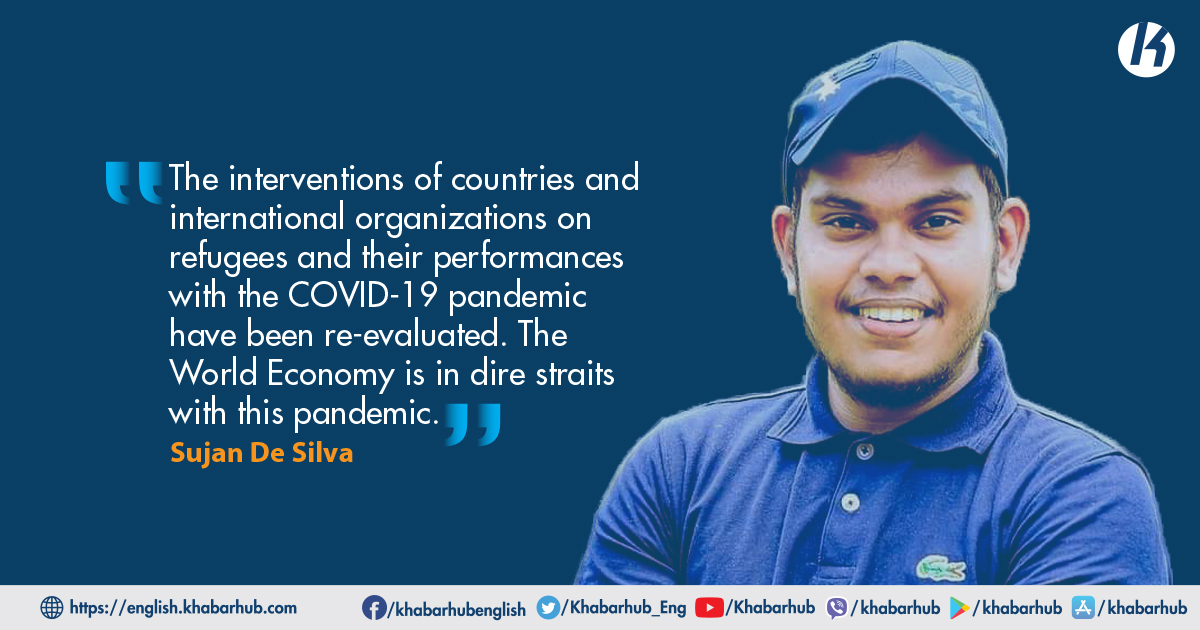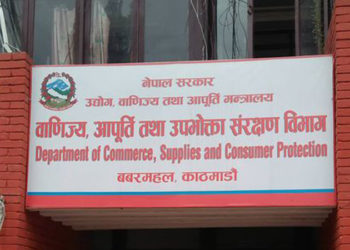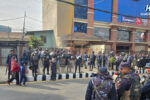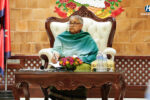Refugees are the people who are forced to flee their homes because of a well- founded fear of persecution, whether on the grounds of race, religion, nationality, or political cause.
This presents a wide practical and analytical review of the basic structure and extent of asylum, the challenges faced by the countries in managing them, the nature of the intervention, and how refugees have been affected by the COVID-19 pandemic.
Refugee can be identified as one of the most pressing issues that need to be addressed in the world today. According to the 2019 UNHCR Report, 2019 has reached the highest number of IDPs in the world, 70.80 million. One in 97 people, or about 1 percent of the world’s population, are still displaced and the number of registered refugees is more than 25 million around the world.
About 84 percent of the world’s refugees are first-time residents of low-middle-income countries, and about 70 percent of refugee families are living below the poverty line. The presence of data reports on displacement is a numerical theory that further demonstrates the quantifiable nature of the displacement.
As a result, refugee camps worldwide are on the rise, and the United Nations estimates that the number of refugees living in camps has risen to 36 percent. Uganda’s recent rise to the world’s largest refugee settlement has overtaken Kenya’s Dadaab refugee camp of over 245,000, making South Sudan the fourth largest host of refugees and the sixth largest refugee producing country, according to the United Nations.
And by the 1980s, nearly 4 million Afghan refugees were living in Pakistan, and that number had fluctuated steadily over the past four decades. Today, one in 10 refugees comes from Afghanistan.
One of the biggest challenges is the difficulty of accessing quality education, skills and education opportunities for refugees. According to 2019 UNHCR report, more than 4 million children have stopped attending school. But it is also worth noting that some countries have adopted a positive approach to the education of these refugees, while the official induction program in Denmark has raised the need for language standardization for refugees for up to five years.
One of the biggest challenges is the difficulty of accessing quality education, skills and education opportunities for refugees. According to 2019 UNHCR report, more than 4 million children have stopped attending school.
Like Sweden and New Zealand, it is advisable to use the theory of refugee education as a choice between regions on the overall profile. Overall, poor education and lack of literacy are unsolved problems for refugees. Low-income countries, like the high-income countries, have failed to make a positive impact on the education of refugees. As a result, more than half of the refugee children are still living in seven countries. Those are the Democratic Republic of the Congo, Ethiopia, Chad, Kenya, Lebanon, Pakistan and Turkey.
According to the 2017 UNICEF report, violence against young girls has more than doubled, and according to UNICEF reports, 32 percent of registered marriages in Syrian refugee camps involve children under the age of 18, while Iraq, Lebanon, Jordan and Egypt, where one-half of all refugee families are women and that most of the marriages in those countries are in the category of underage marriage. Furthermore, women fleeing Guatemala, El Salvador and Honduras in Central America are frequently threatened with violence, and most of them are classified as underage mothers.
HARASS map shows a gradual increase in the number of refugee women recently incarcerated in Egypt and at the same time, domestic Gender Based Violence (GBV) is on the rise is well. Eradication of all forms of discrimination against refugee women is also important, and Ethiopia should be commended for its efforts to combat women violence in refugee camps.
Countries and international organizations have also taken some important and successful initiatives for the economic well-being of refugees globally. Ethiopia’s Jijiga, ILO 2019 Proposals for the Improvement of Trade Systems for Refugees and Host Communities Consumer market study in the Kukuma area of Kenya through IFC 2018 and the UNHR 2014, 2015, 2016, 2017, 2018, 2019 reports on the economic aspirations of the refugees are also important opportunities to identify refugee issues and guide them. GLMLIC 2017, CGDEV 2019 is also important to note here.
The International Monetary Fund (IMF) is also proposing financial assistance for the modernization of refugee response through a 2018 international agreement, and the United Nations in collaboration with the United Nations Women Leadership Project on Aboriginal Women in Economic, Social and Cultural Impact Successful steps towards improvement must be evaluated.
Further, the WMC has presented six recommended areas for livelihood building, such as training and placement programs, financial assistance for work, building a camp economy, agrarian intervention, micro finance and enterprise development.
The interventions of countries and international organizations on refugees and their performances with the COVID-19 pandemic have been re-evaluated. The World Economy is in dire straits with this pandemic. With this epidemic, the world economy is in serious crisis, with the higher economy falling by 7 percent.
The Asian Development Bank emphasized that Asia’s growth rate will fall from 5.2 percent to 2.2 percent this year. In this scenario, the world unemployment rate is set to reach 8.5 percent in May 2020, the highest unemployment rate in the world over the past decade. It should be noted that in this situation, it is extremely difficult to maintain projects focused on refugees.
In this rapidly spreading Covid-19 virus situation, the immediate removal of vulnerable refugees is important. Libya has asked the Doctors without Borders Organization (MSF) and European states to set up a humanitarian corridor to remove these vulnerable migrants. MSF has already issued guidelines for the immediate evacuation of refugees over the age of 60 from Greek islands.
It is also important to note that a Task Force on Transitional Mobility has already been established in collaboration with Hand in Hand for Aid and Development Organization (HIHFAD), World Health Organization (WHO), Eastern Mediterranean Regional Office (EMRO), International Organization for Migration (IOM), The United Nations Economic and Social Commission for West Asia (ESCWA).
The World Health Organization (WHO) has established a 24-hour Bureau for the Health and Safety of over 1 million Rohingya refugees in Cox’s Bazar, Bangladesh. In addition, WHO provided Personal Protective Equipment (PPEs), personal hygiene products and disinfectants to refugee and immigrant reception centers around the world and The United Nations High Commissioner for Refugees (UNHCR) has requested $ 255 million for emergency measures to mitigate the effects of the COVID-19 eruption is well. Mexico has developed COVID-19 educational materials for the management of immigrants and refugees in advance.
It is also important to note that a Task Force on Transitional Mobility has already been established in collaboration with Hand in Hand for Aid and Development Organization (HIHFAD), World Health Organization (WHO), Eastern Mediterranean Regional Office (EMRO), International Organization for Migration (IOM), The United Nations Economic and Social Commission for West Asia (ESCWA).
In addition, Covid-19 has provided advisory migrant refugee telephone numbers in Bammer, Lao and Burma, while enhancing the effectiveness of Singapore’s Wi-Fi technology, the receiver and the need for immediate intervention in emergency situations. While experiencing with Covid-19 the standard of technical intervention can also be presented. In this scenario, the global campaign to protect and defend the world’s refugees against the Covid-19 has been launched globally.
In the face of this deadly virus, the number of refugee deaths in control is a huge achievement. Furthermore, according to UNHCR, 131 refugee hosting countries have received COVID-19 community transmissions, but these impacts have been mitigated.
In the face of this health crisis, the United Nations Human Rights Council has also temporarily halted the resettlement of refugees from March 17, 2020, and the IRCC’s temporary suspension of immigration debt collection until September 6, 2020, as a relief for migrants and refugees but there are reports that no migrants or refugees have been tested positive for COVID-19 in Serbia, which a very unfortunate situation.
Nine is developing countries, including Uganda, Nicaragua and Zimbabwe, where large numbers of refugees live, have doubled their cases in less than a week, making the Covid-19 virus a social problem that goes beyond health problem.
Most of the experts opinion s that the inclusion of refugees with host communities in the global national and regional health response plan and social security schemes, the principle of non-refoulement on a proper program for working with refugee-hosting and returning countries, and international human rights and refugee law Respectfully, strategies for border management are important depending on this situation.
In this backdrop, this year’s World Refugee Day was held on June 20th, with a standardized knowledge that a competing technological society can successfully cope with a life-threatening refugee life by creating a conducive environment for refugees in a challenging global pandemic. It is important to create the environment necessary to live independently in the world. The truth is that the topic of refugees who have not been properly addressed in the general society, over and over again, is very timely and important.
(Sujan De Silva is student at Faculty of Law, University of Colombo and Researcher at Nepal Institute for International Cooperation and Engagement)









Comment